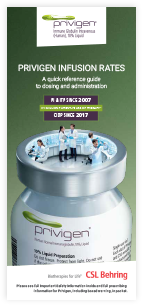- If you choose to administer the maintenance dose over 2 consecutive days, divide the total dose above by 2 and administer that amount each day.
- Assess corresponding infusion time by dividing by the number of consecutive infusion days.
Privigen is a ready-to-use 10% liquid intravenous immunoglobulin
(IVIg) with no warming or reconstitution necessary. It should be
given by a separate infusion line and not mixed with other
intravenous medications.*
See the chart below or use the dosing calculator to find the recommended dosage for your patient.
| Dose | 200–800 mg/kg (2–8 mL/kg) every 3–4 weeks |
| Initial infusion rate | 0.5 mg/kg/min (0.005 mL/kg/min) |
| Maximum infusion rate (if tolerated) | Increase to 8 mg/kg/min (0.08 mL/kg/min) |

Monitor the patient’s vital signs throughout the infusion. Slow or stop the infusion if adverse reactions occur. If symptoms subside promptly, the infusion may be resumed at a lower rate that is comfortable for the patient.
For patients at risk of thrombosis, renal dysfunction, or renal failure, administer Privigen at the minimum dose and infusion rate practicable.
| Dose | 1 g/kg (10 mL/kg) daily for 2 consecutive days |
| Initial infusion rate | 0.5 mg/kg/min (0.005 mL/kg/min) |
| Maximum infusion rate (if tolerated) | Increase to 4 mg/kg/min (0.04 mL/kg/min) |

Monitor the patient’s vital signs throughout the infusion. Slow or stop the infusion if adverse reactions occur. If symptoms subside promptly, the infusion may be resumed at a lower rate that is comfortable for the patient.
For patients at risk of thrombosis, renal dysfunction, or renal failure, administer Privigen at the minimum dose and infusion rate practicable.
| Loading dose |
2 g/kg (20 mL/kg) in
divided doses over 2 to 5
consecutive days Maintenance dose† 1 g/kg (10 mL/kg) administered in 1 to 2 infusions on consecutive days, every 3 weeks |
| Initial infusion rate | 0.5 mg/kg/min (0.005 mL/kg/min) |
| Maximum infusion rate (if tolerated) | Increase to 8 mg/kg/min (0.08 mL/kg/min) |

Monitor the patient’s vital signs throughout the infusion. Slow or stop the infusion if adverse reactions occur. If symptoms subside promptly, the infusion may be resumed at a lower rate that is comfortable for the patient.
For patients at risk of thrombosis, renal dysfunction, or renal failure, administer Privigen at the minimum dose and infusion rate practicable.
 Patient Profile
Patient Profile
 Infusion Rate
Infusion Rate
| 0.3 min |
2.4 max 4.8 max 4.8 max |
| Initial |
0.5 mg/kg/min (0.005 mL/kg/min) |
| Maintenance (as tolerated) |
Increase to 4 mg/kg/min (0.04 mL/kg/min) |
| Initial |
0.5 mg/kg/min (0.005 mL/kg/min) |
| Maintenance (as tolerated) |
Increase to 8 mg/kg/min (0.08 mL/kg/min) |
| Initial |
0.5 mg/kg/min (0.005 mL/kg/min) |
| Maintenance (as tolerated) |
Increase to 8 mg/kg/min (0.08 mL/kg/min) |
 Calculated
CalculatedPlease consult the prescribing information for complete dosing and infusion information.
Download a PDF of dosing and infusion rates based on patient weight or use the calculator above to find precise dosing information for each patient.

To order, contact your GPO or distributor, or speak with your CSL Behring sales representative.


Privigen Connect can help. It’s your single source for Ig solutions from CSL Behring. Find out more or call 877-355-4447 to speak with an expert.
When starting new patients on Privigen therapy:
If you are transitioning patients from another Ig product to Privigen:
Patients receiving Privigen should be observed and monitored carefully throughout the infusion. If adverse reactions occur, the infusion should be slowed or stopped until the symptoms subside. The infusion may then be resumed at a lower rate that is comfortable for the patient. Following are some other things to keep in mind:
Thrombosis may occur with immune globulin products, including Privigen. Risk factors may include: advanced age, prolonged immobilization, hypercoagulable conditions, history of venous or arterial thrombosis, use of estrogens, indwelling vascular catheters, hyperviscosity, and cardiovascular risk factors
Renal dysfunction, acute renal failure, osmotic nephrosis, and death may be associated with the administration of Immune Globulin Intravenous (Human) (IVIg) products in predisposed patients. Administer IVIg products at the minimum dose and infusion rate possible. Renal dysfunction and acute renal failure occur more commonly in patients receiving IVIg products containing sucrose. Privigen does not contain sucrose.
Privigen is contraindicated in patients with history of anaphylactic or severe systemic reaction to human immune globulin, in patients with hyperprolinemia, and in IgA-deficient patients with antibodies to IgA and history of hypersensitivity.
Please see Important Safety Information and full prescribing information.